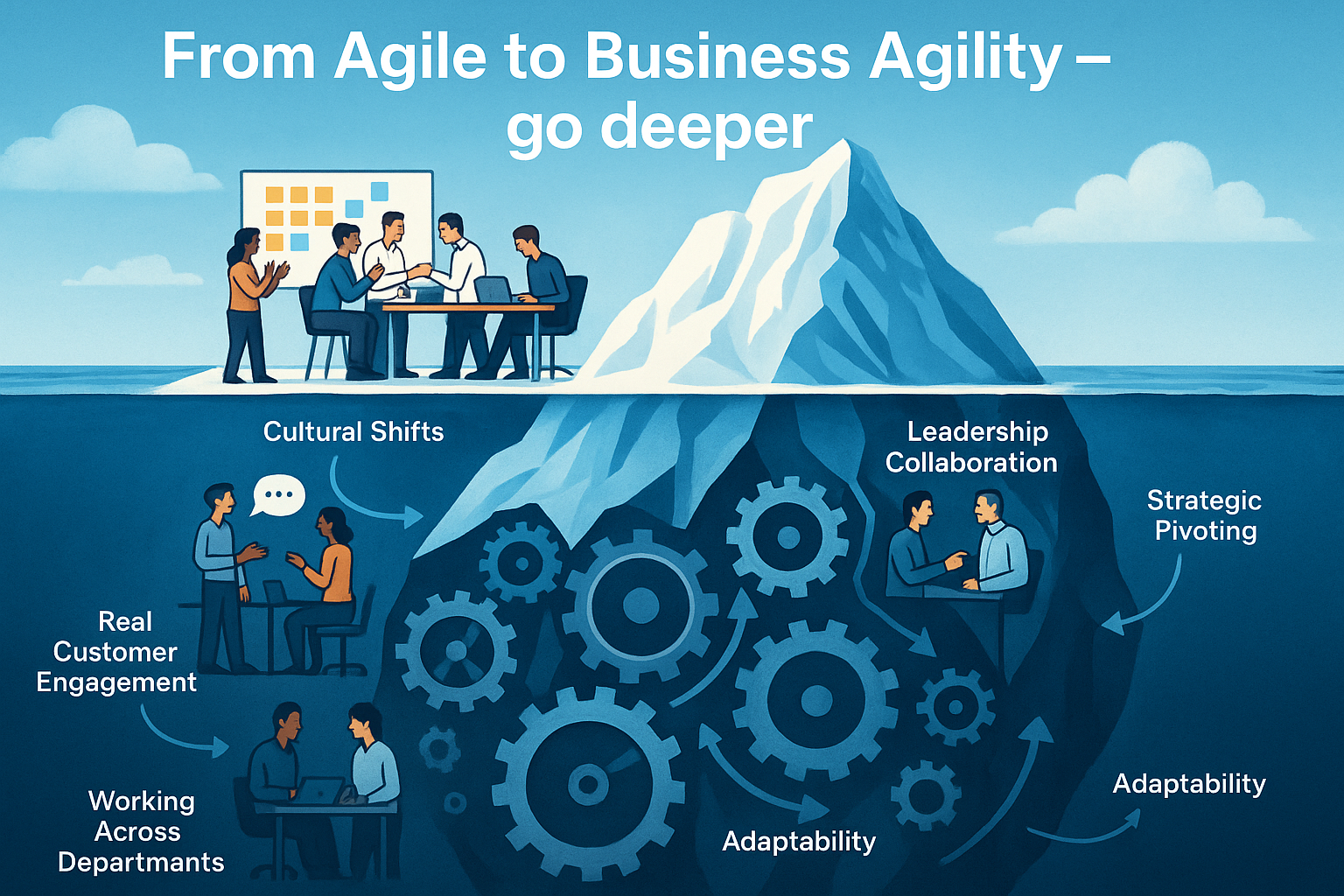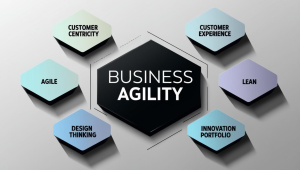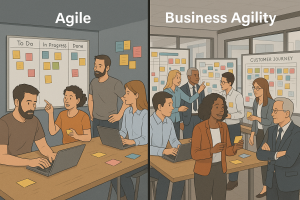
“Why on earth if we’ve been doing Agile for years are we not seeing the impact we expected?”
If this question is going around the corridors of your organization… read on, this article is for you.
Today we are going to talk about a topic that I hear more and more in talks, forums and customer sessions: how to scale Agile to Business Agility. But not just any old way. Let’s see how to do it for real, without staying on the surface, without filling the company with “soulless Daily Standups” or post-its that don’t change the business.
Agile ≠ Business Agility
Let’s start by clarifying concepts. Doing Agile is not the same as having Business Agility.
- Agile was born in the software world, with methodologies such as Scrum, Kanban, XP. Its focus: to improve value delivery in development teams.
- Business Agility, on the other hand, is the organizational ability to change, learn and pivot business strategy quickly and effectively, adapting to an increasingly uncertain and changing marketplace.
Spoiler alert: Business Agility is not a framework, not a course, not a certificate. It is a profound change of mindset, structure and culture.
From Agile to Business Agility
Many organizations have embarked on the path to agility, adopting frameworks such as Scrum or SAFe.
But it is common to remain in surface agility: teams doing agile ceremonies while the culture, structure and decision making remain traditional.
This gives rise to the phenomenon of Agile Theater (also known as Cargo Cult): agile practices without real change, if you don’t know it I leave you this video where a very nice guy tells you about it.

Fortunately, adopting Agile can be the first step toward a deeper transformation: scaling Agile to Business Agility, taking agility beyond IT to permeate the entire organization.
The next big step is to scale agile to business agility, that is, to extend agile principles beyond the IT or project department, permeating the entire organization.
But this leap is not trivial.
It requires a profound change in culture, leadership and business models.
In this article we will explore how to make this transition authentically, avoiding shortcuts and “agile posturing”, and building true Business Agility that enables the enterprise to thrive in an uncertain and changing environment.
Why scale Agile to Business Agility?
Three compelling reasons:
The market is moving faster than ever: you need to adapt in real time.
The customer is at the center: having Agile teams is useless if the strategy does not put the customer at the center.
Innovation is continuous: you need structures that drive it, not hold it back.
Without Business Agility, you can end up with “agile teams in a slow company”. I have seen companies with 20 Scrum teams working flat out, but when they want to launch a new product… 6 months of bureaucratic approvals and meetings to define requirements! That’s not Business Agility.
The most common mistake: staying in the “Agile Theater” (aka Cargo Cult).
Many organizations start well: Scrum training, self-organized teams, visual management…

And they end up trapped in the superficial:
Dailies which are status meetings.
OKRs with no connection to the strategy.
Teams that iterate without really changing their value proposition.
Result: much ceremony, little impact. That’s why it’s key to understand how to truly scale Agile to Business Agility.
Why many companies get stuck in “surface Agile”.
Unfortunately, it is not uncommon to see companies that start the Agile transformation but, after the first few sprints, begin to run into limitations.
The symptoms of stagnation in Surface Agile are clear:
Teams without shared purpose.
Empty or non-existent retrospectives.
Rigid hierarchies that prevent quick decisions.
HR, finance or legal processes that slow down agility.
A culture that “complies with Agile” but doesn’t live it.
The problem? It’s not just a question of frameworks or tools. It is that the transformation does not reach culture, leadership and management systems. Scaling agile to business agility requires transforming culture, leadership, structures and management systems.
The 6 levers for scaling Agile to Business Agility

Based on the 6 dimensions framework of Business Agility, as an agile consultancy we tell you how you can use them to move to the next level:
Customer Centricity
If your Agile teams work well but no one talks to customers… we’re in trouble.
Listening to the customer should be part of the daily work of all teams, not just UX.
Tools such as Empathy Map or Customer Journey help the entire organization to focus on real problems.
Example: Michelin changed its strategy by listening to the customer, even against its sales interests.
Customer Experience
It’s one thing to know the customer, it’s another to design memorable experiences.
Here Design Thinking is your ally. It is not only about optimizing the “user journey” in the app, but also about thinking end-to-end in the whole experience.
If your IT team is agile, but Marketing and Customer Care follow rigid processes, the experience will be inconsistent.
Scaling Agile to Business Agility involves aligning the entire organization to design and deliver customer experiences that stand out.
.. beyond IT equipment
Yes, Agile remains a mainstay. But it can’t stop at delivery.
When we talk about scaling Agile to Business Agility, it means:
Take Agile to business (product management, marketing, finance…).
Using live OKRs that connect teams to strategy. –> OKR Consulting
Foster a culture of transparency, adaptation and continuous improvement.
Designing memorable end-to-end experiences requires all departments to collaborate.
Design Thinking is key here. But if marketing or customer service is not agile, the experience will be inconsistent.
Remember: Business Agility is not about doing more Scrum, it’s about thinking agile.
Lean
Another big overlooked one. Many companies do Agile, but are still full of waste.
Lean teaches us to:
- Eliminate activities that do not add value.
- Optimize end-to-end delivery flow.
- Encourage systems thinking.
Value Stream Mapping is a key tool to see where your organization is slowing down.
For example, I tell you how a client discovered that the bottleneck in their customer onboarding process was… in the legal area! Not in the Agile teams.
Design Thinking
Innovation is an essential part of scaling Agile to Business Agility.
Design Thinking contributes:
- Empathy with the user.
- Creativity to devise solutions.
- Speed to experiment.
What we want is for the whole organization to innovate continuously, not just the “innovation department”.
Innovation Portfolio
Does your company have a balanced innovation portfolio?
Often the backlog is full of small initiatives (incremental improvements), but there is no room for disruptive innovation.
Scaling Agile to Business Agility involves managing a portfolio of initiatives:
- Incremental.
- Adjacent.
- Disruptive.
To have an innovation portfolio with initiatives focused on different horizons, fully aligned with the company’s strategy.
As Steve Blank used to say:
“Innovation is not luck, it’s a system”.

Another focus on key changes to move from Agile to Business Agility
If you do not want to continue with the 6 dimensions of Business Agility and want to see another approach on the fields to work on to move from Agility to Business Agility:
Evolutionary leadership
Moving to Business Agility requires a radical change in leadership style.
From “controlling leader” to empowering leader.
From “I decide” to we co-create.
From “I command and expect results” to I trust, inspire and empower.
Agile leadership is more servant than directive. It is based on:
- Actively listen to the teams.
- Eliminate obstacles
- Promote continuous learning.
- Create a shared purpose.
- Encourage self-organization
Real change begins with leadership. Consult our organizational transformation service.
Flexible structures
Many attempts to scale agile to business agility fail because organizational structures remain vertical and compartmentalized.
For true business agility is key:
- Breaking functional silos.
- Create value-oriented multidisciplinary teams.
- Establish internal collaboration networks.
- Redesign the organizational architecture to favor information flow and adaptability.
A more fluid and less hierarchical network structure is essential.
This does not imply that it is necessary to change the entire organizational chart of the company, but perhaps we need to rethink the way we organize ourselves using an “operating model”.
Culture of learning and experimentation
A company that wants to continuously improve needs to focus on learning and experimentation. To adopt Business Agility requires a culture where:
- The error is seen as a learning opportunity.
- Curiosity is a key value.
- Continuous improvement is encouraged.
- Employees can experiment with new ideas.
If the culture continues to penalize failure or reward blind compliance, agility will be superficial.
Agile support processes
It is not enough for product teams to be agile. It is necessary that areas such as:
- Finance
- HR
- Legal
- Compliance
- Shopping
align with agility.
For example:
- Finance that allows for flexible and adaptive budgets.
- HR that design careers and evaluations compatible with autonomy and collaboration.
- Legal policies that do not hinder experimentation
This is the only way to scale agile to business agility in a systemic way.
Agile strategic approach
Finally, the highest level of Business Agility is when the strategy itself becomes agile:
- Frequent reviews of strategic priorities.
- Adaptive planning.
- Decisions based on real-time data.
- Continuous incorporation of customer feedback.
- Radical transparency in objectives and results.
When strategy and execution are seamlessly aligned, the entire organization can move with agility.
Common barriers when scaling Agile to Business Agility
Not everything is a bed of roses, and you know it!
To summarize, here are the main barriers when trying to scale Agile to Business Agility:
- Traditional management mindset → “We’ve always done it that way here.”
- Structural silos → Agile teams in a sea of hierarchies.
- Legacy processes → Bureaucracy that kills agility.
- Lack of adaptive leadership → New leadership style needed.
Practical roadmap to get started
Diagnose the real agility level of your organization.
Identifies systemic blockages.
Invest in agile leadership.
Connect the strategy with real customer feedback.
Visualize and optimize the value stream.
Design a coherent innovation portfolio.
Implements a continuous improvement system.
It’s not about more Agile, it’s about a more agile business.
Scaling agile to business agility is one of the biggest challenges and at the same time one of the biggest opportunities for organizations today.
The world is increasingly uncertain, complex and changing. The companies that know how to adapt quickly, learn constantly and put the customer at the center will be the ones that prosper.
But to achieve this, it is not enough to “do Agile”. We have to be agile in the deepest sense, rethinking how we lead, how we collaborate, how we make decisions and how we create value.

It is an exciting journey. And it is worth traveling it with authenticity, courage and a real commitment to change.
Scaling Agile to Business Agility is not about doing more Scrum. It’s about transforming the business to be more adaptive, innovative and customer-centric.
Remember:
- Agile teams are not enough → you have to transform the structure and culture.
- It is not enough to iterate → you have to generate business impact.
- It is not enough to “do Agile” → you have to “think Agile”.
If you have made it this far, thank you!
My invitation: reflect on your organization
Where are you really on the road to Business Agility?
And if you are interested in deepening or sharing experiences, you know… let’s talk! Asexperts in Organizational Transformation and Agile, we can help you.



